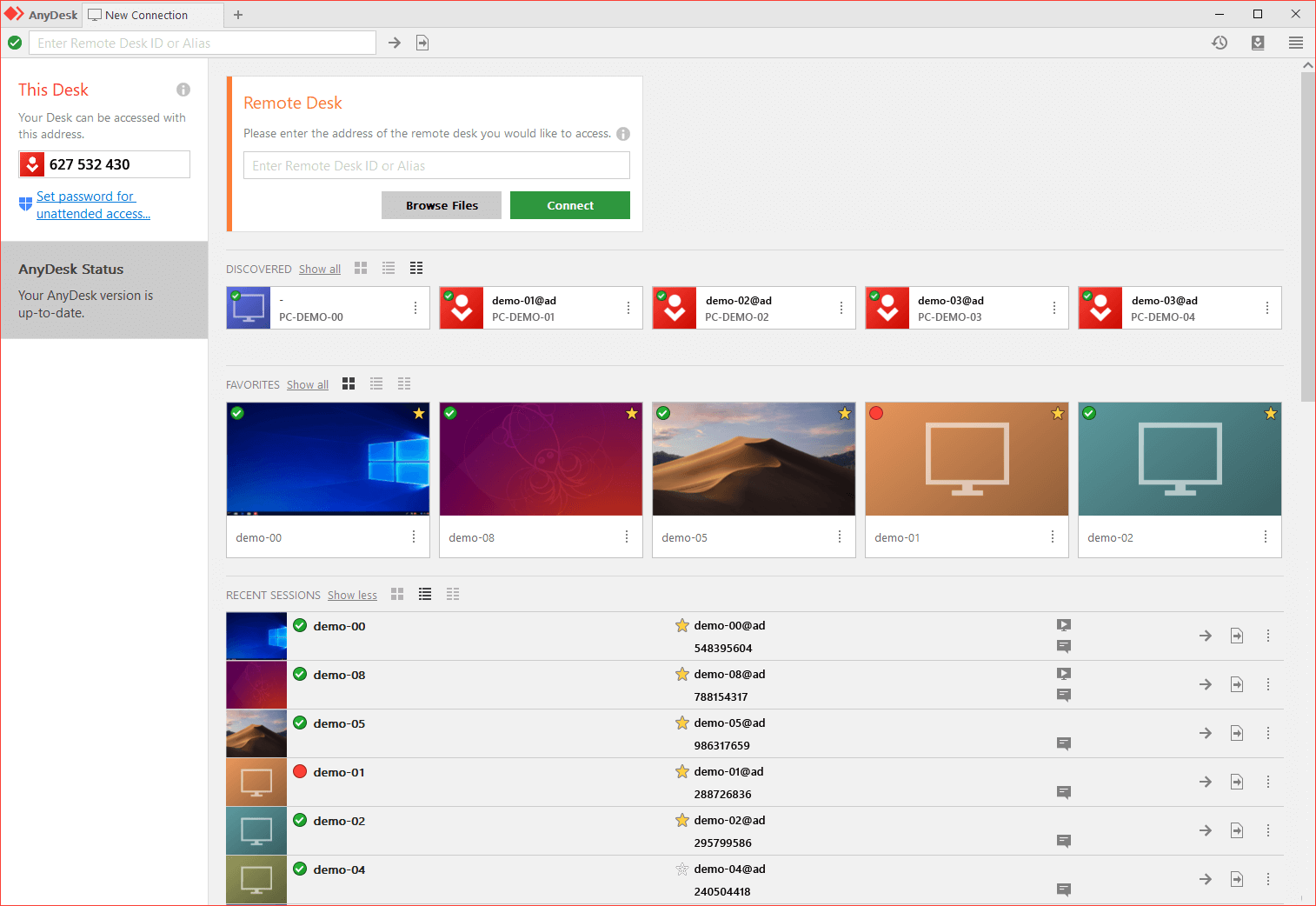The AnyDesk Audio Feature transmits sound from the remote device to the local device.
- Is AnyDesk harmful for my system? AnyDesk is a safe software for remote connections, while frauds are possible if you give access to a fraudulent person. For the latest deals, offers and news, follow HotDeals360 on Facebook, Twitter, Instagram, Google News and subscribe to our YouTube channel.
- Therefore, the presence of AnyDesk's modified version can lead to high-risk computer infections and serious privacy issues. The desktop shortcut of the malicious version is called ' AnyDask ' and its entry in the list of installed programs is ' AnyDeskApp '.
- In February, Reserve Bank of India (RBI) issued warning regarding a remote desktop app known as 'AnyDesk', which was employed by scammers to carry out unauthorized transactions from bank accounts of the customers via mobile or laptop. In the wake of RBI's warning, various other banks such as HDFC Bank, ICICI Bank and Axis Bank along with a few.
- Welcome to the AnyDesk Blog. Go back to all articles. 4 Questions to Ask to Avoid Online Scams. Answering a few simple questions may not seem dangerous. We feel as though we are in control the entire time. But it’s still possible to be lured into a deal you might not want or, in the worst case, be convinced to disclose confidential data.

Like other dangerous emails, these are trying to grab your curiosity so you act quickly. When you think about it for a bit, though, it's clear that these are fake. AnyDesk, or similar. Once they connect to your computer, they'll ask you to log into your bank. They claim that they need to do this to process the refund. Again, this should.
It can be enabled or disabled in the 'Permissions'-section of the Accept Window before or during an AnyDesk session, as well as in the 'Permissions'-settings at the top of the AnyDesk window during a session.
Initially, the correct audio devices have to be selected in the AnyDesk client under 'Settings' > 'Audio':
Setting up audio transmission
'Transmission' sets up which audio device the client transmits, when it receives an incoming connection. The default setting will be use the standard audio device that has been selected in the computers settings.
| Option | Function |
|---|---|
| Disable | No audio transmission |
| Use standard device | Transmits the default audio device set in the computers settings. |
| Transmit audio output of this desk | Transmits the audio output of all devices on this computer. |
| Specify device | A specific device can be selected for transmission. It is possible to select a microphone here. |

Setting up audio output
“Output” is responsible for which device the audio is played back on when the client starts an outgoing session. The default setting will use the standard audio device that has been selected in the computers settings.
Is Anydesk Dangerous
| Option | Function |
|---|---|
| Disable | No audio output on this device. |
| Use standard device | Use the default audio output device set in the computers settings. |
| Specify device | A specific device can be selected as audio output. |
| Exclusive audio playback | Reduces audio latency but will disable any audio output that doesn't come from AnyDesk. |
Windows settings
When using audio transmission, the Windows system settings need to be set up properly.
In case of issues with the transmission, these should be checked first.
The correct default audio devices needs to be set up, as this is what AnyDesk uses in it's standard configuration.
The windows audio settings are found in 'Windows System Settings' > 'System' > 'Sounds' and then under 'Related Settings' to the right 'Sound Control Panel'.
In the 'Sound Control Panel' under the 'Playback'-tab, it is important the device that is intended to be used for audio output is set as default, by clicking 'Set Default'.
Is ransomware really that dangerous
AnyDesk Virus is file-encrypting ransomware. Ransomware commonly enters PCs via spam emails or fake downloads, and it is rather probable that this one uses those very methods. Ransomware is thought to be a very damaging malware as it encrypts files, and requests for payment in exchange for recovering them. If file-encoding malware analysts are able to crack the ransomware, they could create a free decryption utility, or if you have backup, file loss may not be an issue. You not having backup might lead to data loss as data recovery using other means isn’t always likely. But there is the option of paying the ransom, you may think, but we must notify you that it doesn’t guarantee data decryption. There are of cases when ransomware developers just take the money and leave files locked. Instead of paying, you ought to delete AnyDesk Virus from your OS.
Download Removal Toolto remove AnyDesk Virus
What does ransomware do
Ransomware does not need complicated distribution methods, and contamination commonly happens through spam email. A contaminated file is adjoined to an email and sent to a lot of users. The ransomware will download onto the OS as soon as the email attachment is opened. Careless or less informed users could be putting their computers in danger by opening every single email attachment that reach their inbox. You can normally differentiate a malicious email from a safe one pretty easily, you simply need to learn the signs. The sender heavily pressing you to open the attachment is a big red flag. Overall, be cautious as any email attachment you get can have ransomware. Another method to get corrupted with file-encrypting malicious software is by downloading from non-legitimate sites, which could be compromised without difficulty. Only rely on dependable pages with legitimate downloads.
By the time the ransomware is seen, it will be too late as it will have encoded your data. All your vital files will be encoded, such as images, videos and documents. After encoding, a ransom note ought to become visible, if it doesn’t open on automatically, it should be located in all folders that hold the encoded data. The note will state that you should pay so as to recover your files. When dealing with cyber criminals, there are no reassurances that they will act one way or the other. So by giving into the demands, you may just be giving away money in exchange for nothing. You aren’t guaranteed to be sent a decoding program after paying, so keep that in mind. Don’t believe that just taking your money and not providing you with anything in return is beneath them. Situations like this are why having backup is so critical, you could just erase AnyDesk Virus and not be anxious about possibly loosing your files. We encourage that you terminate AnyDesk Virus and instead of paying the ransom, you buy backup.
AnyDesk Virus uninstallation
We encourage you to download professional malware removal software and have it delete AnyDesk Virus for you. The process of manual AnyDesk Virus removal could be too complex to perform safely, so we do not recommend it. We need to note, however, that the security software will not decrypt your files, it will only eliminate AnyDesk Virus
Learn how to remove AnyDesk Virus from your computer
1. Remove AnyDesk Virus using Safe Mode with Networking.
1.1. Step 1. Access Safe Mode with Networking.
For Windows 7/Vista/XP
- Start → Shutdown → Restart → OK.
- Press and keep pressing F8 as many times as it takes for Advanced Boot Options to appear.
- Choose Safe Mode with Networking.
For Windows 8/10 users
- Press the power button that appears at the Windows login screen. Press and hold Shift. Click Restart.
- Troubleshoot → Advanced options → Startup Settings → Restart.
- Choose Enable Safe Mode with Networking.
1.2. Step 2. Remove AnyDesk Virus.
You should now be able to access your browsers, which you need to use to download a reputable anti-malware program. Pick one that you think suits you the best and scan your computer. When the ransomware is found, remove it with the program. If you are unable to access Safe Mode with Networking, continue to below.2. Remove AnyDesk Virus using System Restore
2.1. Step 1. Access Safe Mode with Command Prompt.
For Windows 7/Vista/XP
- Start → Shutdown → Restart → OK.
- Press and keep pressing F8 as many times as it takes for Advanced Boot Options to appear.
- Select Safe Mode with Command Prompt.

For Windows 8/10 users
- Press the power button that appears at the Windows login screen. Press and hold Shift. Click Restart.
- Troubleshoot → Advanced options → Startup Settings → Restart.
- Choose Enable Safe Mode with Command Prompt.
2.2. Step 2. Restore files and settings.
- In the window that appears enter cd restore. Press Enter.
- Type in rstrui.exe and press Enter.
- Press Next on the window that pop-ups.
- Select the restore point and press Next.
- Press Yes.
3. Recover your data
If you did not invest into reliable backup, there is still a chance you can get your files back. You can try one or all of the following ways and you might be in luck!3.1. Using Data Recovery Pro.
- Obtain Data Recovery Pro.
- Install and launch it.
- Scan your computer for files that can be recovered.
- Restore them.
3.2. Recover files via Windows Previous Versions
Anydesk Is It Safe
If System Restore was enabled on your system, you can recover encrypted files via Windows Previous Versions.- Find an encrypted file you want to recover and right-click on it.
- Select Properties and then press Previous versions.
- Choose what version you want and click Restore.
3.3. Using Shadow Explorer to recover files
If the ransomware did not delete the shadow copies that your operating system automatically makes, you can recover them.Is Anydesk Safe To Use
- Obtain Shadow Explorer from the official website, install and open it.
- In the drop down menu, you need to select the disk with encrypted files.
- Click Export on the files that can be recovered.
Site Disclaimer
pc-threat.com is in no way linked, sponsored, owned or affiliated with any malware developers or distributors referenced in this article. We do not promote or support any kind of malware. Our aim is to provide information about potential computer threats so that users can safely detect and eliminate the malware. You can do so by following the manual removal guides or using anti-malware tool to aid you in the process.
The article is only meant for educational purposes. By using this website, you agree to the disclaimer. We do not guarantee that our removal guides will be able to solve your computer malware issues. Because malware changes constantly, manual removal does not always work.

Comments are closed.